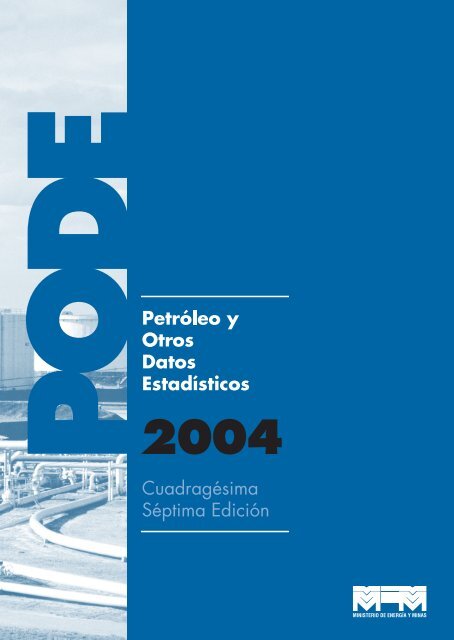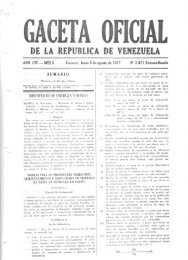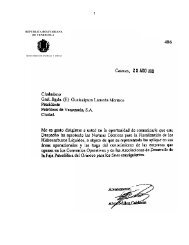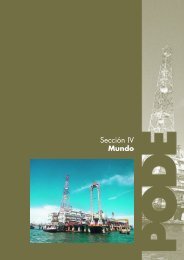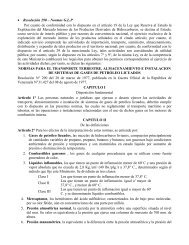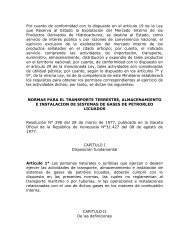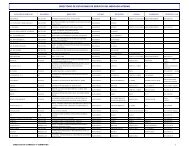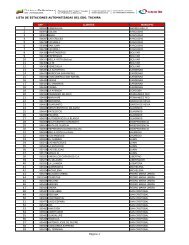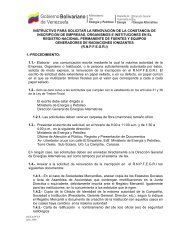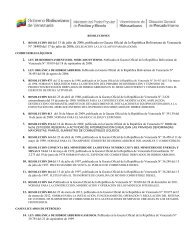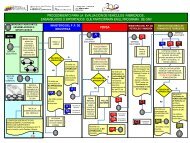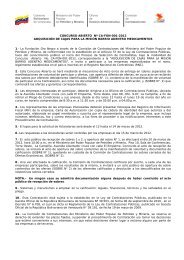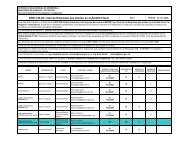Notas Generales - Ministerio del Poder Popular de Petróleo y Minería
Notas Generales - Ministerio del Poder Popular de Petróleo y Minería
Notas Generales - Ministerio del Poder Popular de Petróleo y Minería
Create successful ePaper yourself
Turn your PDF publications into a flip-book with our unique Google optimized e-Paper software.
PODE 2004El <strong>Ministerio</strong> <strong>de</strong> Energía y <strong>Petróleo</strong> -a través <strong>de</strong> la Coordinación Sectorial <strong>de</strong> Estadísticas, PreciosInternacionales y Economía- se complace en presentar a los investigadores y analistas <strong><strong>de</strong>l</strong> Sector<strong>de</strong> Hidrocarburos, así como al público en general, la cuadragésima séptima edición <strong><strong>de</strong>l</strong> anuario“PETRÓLEO Y OTROS DATOS ESTADÍSTICOS” (PODE), correspondiente al año 2004.El objetivo fundamental <strong>de</strong> este documento es difundir la información estadística en materia <strong>de</strong>petróleo, gas, petroquímica y energía <strong>de</strong> Venezuela, la Organización <strong>de</strong> Países Exportadores <strong>de</strong><strong>Petróleo</strong> (OPEP) y el Mundo. En esta Edición se han incorporado dos nuevas secciones en lascuales se presenta información sobre América Latina y el Mercado Petrolero Mundial.La Coordinación Sectorial <strong>de</strong> Estadísticas, Precios Internacionales y Economía expresa su agra<strong>de</strong>cimientoa Organismos e Instituciones Nacionales e Internacionales que suministraron informaciónque sirvió <strong>de</strong> insumo para esta nueva edición.Finalmente, esperamos contar con las opiniones y sugerencias <strong>de</strong> los usuarios <strong><strong>de</strong>l</strong> PODE quepermitan mejorar futuras ediciones <strong><strong>de</strong>l</strong> Anuario.Caracas Octubre 20061
PODE 2004ÍNDICENOTAS GENERALESDefiniciones 14Organizaciones y Agrupaciones Económicas Internacionales 18Organizaciones Energéticas Regionales 18Organizaciones Energéticas Internacionales 19Agrupaciones <strong>de</strong> Países 20Abreviaturas y Siglas 21Factores <strong>de</strong> Conversión 23SECCIÓN I. VENEZUELAMarco Jurídico 26A. EconomíaVenezuela: Indicadores Económicos 28Venezuela: Población y Distribución <strong>de</strong> la Fuerza Laboral 29Contribución <strong><strong>de</strong>l</strong> Sector Petrolero a la Inversión Social 30Planes <strong>de</strong> Inversión Social 30Producto Interno Bruto por Clase <strong>de</strong> Actividad Económica a Precios Corrientes y a Precios Constantes 31Ingreso Nacional y Producto Interno Bruto a Precios Corrientes 31Producto Interno Bruto a Precios Constantes 32Contribución <strong><strong>de</strong>l</strong> Sector Petrolero al Producto Interno Bruto 32Valor Agregado Bruto <strong><strong>de</strong>l</strong> Sector Petrolero a Precios Corrientes 32Distribución Sectorial y Factorial <strong><strong>de</strong>l</strong> Ingreso Interno 33Distribución <strong>de</strong> los Ingresos Directos <strong>de</strong> Divisas 34Tasa <strong>de</strong> Inflación, Tasa <strong>de</strong> Cambio e Impuesto sobre la Renta <strong>de</strong> la Industria Petrolera 34Venezuela: Inversión Extranjera Directa Registrada en los Sectores Hidrocarburo y Petroquímica 35B. <strong>Petróleo</strong>B. 1. Sumario <strong>de</strong> las Activida<strong>de</strong>s <strong>de</strong> la Industria Petrolera 36Venezuela: Resumen <strong>de</strong> la Industria Petrolera 36Venezuela en la OPEP: Principales Indicadores Petroleros, (Gráfico) 37Venezuela: Reservas Probadas <strong>de</strong> Hidrocarburos, 2004 37Venezuela: Relación Reservas / Producción <strong>de</strong> Hidrocarburos, (Gráfico) 38Producción <strong>de</strong> <strong>Petróleo</strong> Crudo, Exportaciones <strong>de</strong> Crudos y Productos, Consumo Internoy Precio <strong>de</strong> Exportación, (Gráfico) 38B. 2. Exploración, Perforación, Reservas y Producción 39Actividad Exploratoria <strong>de</strong> la Industria Petrolera 39Balance <strong>de</strong> la Actividad Perforatoria por Tipo, 2004 41Balance <strong>de</strong> los Pozos <strong>de</strong> Inyección <strong>de</strong> Fluidos, 2004 42Estado <strong>de</strong> los Pozos <strong>de</strong> <strong>Petróleo</strong> Completados 42Pozos <strong>de</strong> <strong>Petróleo</strong> y Gas en Producción por Jurisdicción 43Reservas Probadas <strong>de</strong> <strong>Petróleo</strong> 43Reservas y Producción Acumulada <strong>de</strong> <strong>Petróleo</strong> (1964-2004) 44Producción <strong>de</strong> <strong>Petróleo</strong> Crudo (1965-2004) 45Producción <strong>de</strong> <strong>Petróleo</strong> por Gravedad 46Producción <strong>de</strong> <strong>Petróleo</strong> por Cuencas 46Producción <strong>de</strong> <strong>Petróleo</strong> en la Cuenca <strong>de</strong> Maracaibo 47Producción <strong>de</strong> <strong>Petróleo</strong> en la Cuenca Oriental 48Producción <strong>de</strong> <strong>Petróleo</strong> en las Cuencas Apure y Falcón 49Producción Fiscalizada <strong>de</strong> Crudo, 2004 50Producción <strong>de</strong> <strong>Petróleo</strong> en Convenios Operativos, Asociaciones Estratégicas,Bitor y Exploración a Riesgo 51Asociaciones Estratégicas <strong>de</strong> la Faja Petrolífera <strong><strong>de</strong>l</strong> Orinoco 52Volumen <strong>de</strong> Producción y Pago <strong>de</strong> Regalía por <strong>Petróleo</strong> 532
PODE 2004ÍNDICEVolumen <strong>de</strong> Producción y Pago <strong>de</strong> Regalía por <strong>Petróleo</strong>, (Gráfico) 54B. 3. Refinación 55Capacidad <strong>de</strong> Refinación por Procesos, 2004 55Crudo Procesado por Refinería 56Asociaciones Estratégicas Faja Petrolífera / Plantas <strong>de</strong> Mejoramiento 56Asociaciones Estratégicas Faja Petrolífera / Plantas <strong>de</strong> Mejoramiento <strong>de</strong> Crudo, 2004 56Balance <strong>de</strong> Refinación Consolidado <strong>de</strong> PDVSA 57Refinerías en el Exterior 58B. 4. Consumo 59Consumo Interno Total <strong>de</strong> Productos Refinados 59Consumo <strong>de</strong> Productos Refinados en el Sector Industria y Uso Doméstico 59Consumo en el Sector Industria y Uso Doméstico por Productos y por Entidad Fe<strong>de</strong>ral 60Demanda Interna Total <strong>de</strong> Productos Refinados por Sectores Económicos 60Consumo <strong>de</strong> Productos Refinados en el Sector Industria y Uso Doméstico por Región 61Productos Refinados Entregados a Naves 61Precio e Impuestos <strong>de</strong> los Productos Refinados en el Mercado Interno 62Precio y Consumo <strong>de</strong> Gasolinas <strong>de</strong> Motor 62Impuesto al Consumo <strong>de</strong> Productos Refinados 62B. 5. Exportación 63Venezuela: Flujo <strong>de</strong> Exportaciones Petroleras, (Mapa) 63Venezuela: Exportaciones <strong>de</strong> <strong>Petróleo</strong> Crudo y Productos Refinados por Países 64Venezuela: Exportaciones <strong>de</strong> <strong>Petróleo</strong> Crudo por Países 65Venezuela: Exportaciones <strong>de</strong> <strong>Petróleo</strong> Crudo por Rango 66Venezuela: Exportaciones <strong>de</strong> Productos Refinados por Países 66Venezuela: Exportaciones <strong>de</strong> Productos Refinados por Tipo 67Venezuela: Exportaciones Petroleras, Precio <strong>de</strong> Regalía, Precio <strong>de</strong> Venta y Valor Fiscal <strong>de</strong> Exportación 67Venezuela: Exportaciones Petroleras Totales y Precios Promedio <strong>de</strong> Ventas, (Gráfico) 68Venezuela: Exportaciones <strong>de</strong> Crudo y Productos, Refinados y Precios <strong>de</strong> Venta, (Gráfico) 68B. 6. Transporte 69Venezuela: Principales Oleoductos 69Venezuela: Flota Petrolera, 2004 70C. Gas NaturalReservas Probadas <strong>de</strong> Gas Natural 71Producción y Distribución <strong><strong>de</strong>l</strong> Gas Natural 71Producción y Distribución <strong><strong>de</strong>l</strong> Gas Natural por Jurisdicción 72Producción y Distribución <strong><strong>de</strong>l</strong> Gas Natural, (Gráfico) 72Plantas <strong>de</strong> Extracción y Fraccionamiento <strong>de</strong> Gas Natural al 2004 73Producción <strong>de</strong> Líquidos <strong><strong>de</strong>l</strong> Gas Natural 74Distribución <strong>de</strong> las Ventas <strong>de</strong> Líquidos <strong>de</strong> Gas Natural 74Consumo Interno <strong>de</strong> Gas Natural 74Precio Promedio <strong><strong>de</strong>l</strong> Gas Metano en el Mercado Interno 75Precios <strong><strong>de</strong>l</strong> Gas Metano en el Mercado Interno por Sectores Económicos 75Precios <strong><strong>de</strong>l</strong> Gas Metano en el Mercado Interno por Región (Bs./M 3 ) 76Precios <strong><strong>de</strong>l</strong> Gas Metano en el Mercado Interno por Región ($/MMBTU) 77Exportaciones <strong>de</strong> Productos Obtenidos <strong><strong>de</strong>l</strong> Gas 77Venezuela: Principales Gasoductos, 2004 78D. PetroquímicaIndicadores <strong>de</strong> la Industria Petroquímica 79Capacidad Nominal <strong>de</strong> Producción <strong>de</strong> la Industria Petroquímica, 2004 79Producción Bruta Consolidada <strong>de</strong> la Industria Petroquímica 80Producción Neta Consolidada <strong>de</strong> la Industria Petroquímica 81Ventas Consolidadas <strong>de</strong> la Industria Petroquímica en el Mercado Nacional (MTM) 82Ventas Consolidadas <strong>de</strong> la Industria Petroquímica en el Mercado Nacional (MBs.) 833
PODE 2004ÍNDICEVentas <strong>de</strong> Mezclas y Productos Primarios en el Mercado Interno 84Ventas Consolidadas <strong>de</strong> la Industria Petroquímica en el Mercado <strong>de</strong> Exportación (MTM) 85Ventas consolidadas <strong>de</strong> la Industria Petroquímica en el Mercado <strong>de</strong> Exportación (MBs.) 86Capacidad <strong>de</strong> Producción Nominal <strong>de</strong> las Empresas Mixtas Petroquímicas, 2004 87Producción <strong>de</strong> Empresas Mixtas Petroquímicas 88Ventas <strong>de</strong> las Empresas Mixtas Petroquímicas, (MTM) 89Ventas <strong>de</strong> las Empresas Mixtas Petroquímicas, (MMBs.) 90E. Aspectos Financieros <strong>de</strong> la IPPCNSumario Financiero <strong>de</strong> la IPPCN, (MMBs.) 91Estado <strong>de</strong> Ganancias y Pérdidas <strong>de</strong> la IPPCN, (MMBs.) 92Estado <strong>de</strong> Ganancias y Pérdidas <strong>de</strong> la IPPCN, (MM$) 93Balance General <strong>de</strong> la IPPCN, (MMBs.) 94Balance General <strong>de</strong> la IPPCN, (MM$) 94Rendimiento <strong><strong>de</strong>l</strong> Capital Fijo Neto <strong>de</strong> la IPPCN, (MMBs.) 95Rendimiento <strong><strong>de</strong>l</strong> Capital Fijo Neto <strong>de</strong> la IPPCN, (MM$) 95Activo Circulante <strong>de</strong> la IPPCN, (MMBs.) 95Activo Circulante <strong>de</strong> la IPPCN, (MM$) 95Capital <strong>de</strong> Trabajo <strong>de</strong> la IPPCN, (MMBs.) 96Capital <strong>de</strong> Trabajo <strong>de</strong> la IPPCN, (MM$) 96Costos <strong>de</strong> Operación Sector Petrolero-Gas 96Costos Unitarios Promedios <strong>de</strong> Producción y Refinación <strong><strong>de</strong>l</strong> Sector Petrolero-Gas 96Compras <strong>de</strong> Materiales y Equipos <strong>de</strong> la Industria Petrolera 96Inversión Acumulada en Activos Fijos <strong>de</strong> la IPPCN 97Desembolsos por Inversiones en Activos Fijos <strong>de</strong> la IPPCN 97Desembolsos por Inversiones en Activos Fijos <strong>de</strong> la IPPCN, por Región 98Venezuela: Distribución <strong><strong>de</strong>l</strong> Ingreso Petrolero Nacional 99Venezuela: Distribución <strong><strong>de</strong>l</strong> Ingreso Petrolero Nacional, (Gráfico) 99Distribución <strong>de</strong> los Ingresos <strong><strong>de</strong>l</strong> Sector Petrolero por Barril Producido 100Estado Consolidado <strong>de</strong> Flujos <strong>de</strong> Efectivo <strong>de</strong> la IPPCN, (MMBs.) 100Estado Consolidado <strong>de</strong> Flujos <strong>de</strong> Efectivo <strong>de</strong> la IPPCN, (MM$) 101F. EnergíaProducción <strong>de</strong> Energía Primaria 102Consumo Total <strong>de</strong> Energía 102Consumo Final Total <strong>de</strong> Energía por Sectores 102Consumo Sector Energético 102Consumo Per-Cápita <strong>de</strong> Energía 103Consumo Final <strong>de</strong> Energía / Producto Interno Bruto 103Consumo Per-Cápita <strong>de</strong> Electricidad 103Energía Neta Generada, Intercambiada, Consumida, Demanda Máximay Capacidad Instalada <strong><strong>de</strong>l</strong> Sistema Eléctrico Nacional 104SECCIÓN II. ORGANIZACION DE PAISES EXPORTADORES DE PETROLEO (OPEP)A. Economía y <strong>Petróleo</strong>OPEP en el Mundo: Principales Indicadores Petroleros, (Gráfico) 106OPEP: Indicadores Económicos y Petroleros 107Población y Producto Interno Bruto Per-Cápita 108Producto Interno Bruto 108Valor <strong>de</strong> las Exportaciones Totales FOB 109Valor <strong>de</strong> las Exportaciones Petroleras FOB 109Participación <strong>de</strong> las Exportaciones Petroleras en las Exportaciones Totales, (Gráfico) 109Precio Ocasional <strong>de</strong> la Cesta <strong>de</strong> Crudos OPEP 110Precio Nominal y Real <strong>de</strong> la Cesta <strong>de</strong> Crudos OPEP, (Gráfico) 1104
PODE 2004ÍNDICEB. <strong>Petróleo</strong> y Gas NaturalReservas Probadas <strong>de</strong> <strong>Petróleo</strong> Crudo 111Taladros Activos 111Producción <strong>de</strong> <strong>Petróleo</strong> Crudo 112Capacidad <strong>de</strong> Refinación 112Producción <strong>de</strong> Productos Refinados por Tipo 113Consumo <strong>de</strong> Productos Refinados 115Exportaciones <strong>de</strong> Crudo y Productos Refinados 115OPEP: Consumo <strong>de</strong> Productos Refinados y Exportaciones Petroleras, 2004, (Gráfico) 115Exportaciones <strong>de</strong> <strong>Petróleo</strong> Crudo 116Exportaciones <strong>de</strong> Productos Refinados 116Exportaciones <strong>de</strong> Crudo OPEP por Región 117Distribución <strong>de</strong> la Flota <strong>de</strong> Tanqueros 117Cuotas <strong>de</strong> Producción 118OPEP en el Mundo: Principales Indicadores Gasiferos, 2004, (Gráfico) 120Reservas Probadas <strong>de</strong> Gas Natural 121Exportaciones <strong>de</strong> Gas Natural 121Producción y Uso <strong><strong>de</strong>l</strong> Gas Natural 122SECCION III. AMERICA LATINAPoblación y Producto Interno Bruto Per-Cápita 126Población y Producto Interno Bruto Per-Cápita, (Gráfico) 126Reservas y Producción <strong>de</strong> <strong>Petróleo</strong> Crudo, 2004 127Reservas y Producción <strong>de</strong> <strong>Petróleo</strong> Crudo por Región, (Gráfico) 128Reservas y Producción <strong>de</strong> Crudo por Países, (Gráfico) 128Producción <strong>de</strong> <strong>Petróleo</strong> Crudo 129Producción <strong>de</strong> <strong>Petróleo</strong> Crudo, (Gráfico) 129Capacidad <strong>de</strong> Refinación 130Exportaciones <strong>de</strong> <strong>Petróleo</strong> Crudo 131Importaciones <strong>de</strong> <strong>Petróleo</strong> Crudo por Países 132Exportaciones e Importaciones <strong>de</strong> <strong>Petróleo</strong> Crudo, (Gráfico) 132Consumo <strong>de</strong> Energía por Fuentes, 2004 133Consumo <strong>de</strong> Energía por Fuentes, 2004, (Gráfico) 133Precios al Consumidor Final <strong>de</strong> Productos Refinados, 2004 134SECCION IV. MUNDOA. Economía OCDECrecimiento <strong><strong>de</strong>l</strong> Producto Interno Bruto 136Producción Industrial 137Balanza en Cuenta Corriente 138Balanza Comercial 138OCDE, Tasa <strong>de</strong> Desempleo 139Tasa <strong>de</strong> Inflación 139B. <strong>Petróleo</strong> y Gas NaturalTaladros Activos 140Reservas Probadas <strong>de</strong> <strong>Petróleo</strong> Crudo 141Reservas Probadas <strong>de</strong> Gas Natural 142Reservas Probadas <strong>de</strong> <strong>Petróleo</strong> Crudo y Gas por Regiones, (Gráfico) 143Producción <strong>de</strong> <strong>Petróleo</strong> Crudo 144Producción Comercializada <strong>de</strong> Gas Natural 146Capacidad <strong>de</strong> Refinación 1485
PODE 2004ÍNDICEProducción <strong>de</strong> Productos Refinados 149Consumo <strong>de</strong> Productos Refinados 151Consumo <strong>de</strong> Gas Natural 152Exportaciones <strong>de</strong> <strong>Petróleo</strong> Crudo 153Exportaciones <strong>de</strong> Productos Refinados 154Exportaciones <strong>de</strong> Gas Natural 155Importaciones <strong>de</strong> <strong>Petróleo</strong> Crudo 156Importaciones <strong>de</strong> Productos Refinados 157Importaciones <strong>de</strong> Gas Natural 158Mundo: Flujo <strong>de</strong> las Transacciones Petroleras, 2004 159C. EnergíaProducción <strong>de</strong> Energía por Fuentes 160Consumo <strong>de</strong> Energía por Fuentes 160Producción <strong>de</strong> Energía por Regiones 160Consumo <strong>de</strong> Energía por Regiones 160Producción y Consumo <strong>de</strong> Energía por Regiones, (Gráfico) 161SECCIÓN V. MERCADO PETROLERO MUNDIAL: PRINCIPALES INDICADORESMercado Petrolero Mundial, (Gráfico) 164Balance Petrolero Mundial 165Producción No-OPEP 166OCDE: Inventarios Totales, (Gráfico) 166Principales Crudos por Gravedad API, (Gráfico) 167Precios Ocasionales <strong>de</strong> Crudos 168Precios Ocasionales <strong>de</strong> Crudos Representativos, (Gráfico) 168Precios <strong>de</strong> Productos Refinados en los Principales Mercados 169Barril Compuesto <strong>de</strong> <strong>Petróleo</strong> 170Barril Compuesto <strong>de</strong> <strong>Petróleo</strong>, 2004, (Gráfico) 1716
PODE 2004ÍNDEXGENERAL NOTESDefinitions 14International Organizations 18Country Groupings 20Abbreviations 21Conversion Factors 23SECTION I. VENEZUELALegal Aspects 26A. EconomyVenezuela: Economic Indicators 28Venezuela: Total Population and Labour Force Distribution 29Petroleum Sector Contribution to Social Investment 30Gross Domestic Product Classified by Economic Activity in Nominal and Real terms 31National Income and Gross Domestic Product in Nominal Terms 31Gross Domestic Product in Real Terms 32Petroleum Sector Contribution to Gross Domestic Product 32Petroleum Sector Gross Ad<strong>de</strong>d Value in Nominal Terms 32Distribution of Internal Income by Sectors and Factors 33Distribution of Direct Incomes of Foreign Currency 34Rate of Inflation, Exchange Rate and Income Tax Rate of the Oil Industry 34Venezuela: Direct Foreign Investment Registered in the Petrochemical and Hydrocarbons Sectors 35B. OilB.1. Summary of the Activities of the Petroleum Industry 36Venezuela: Summary of the Oil Industry 36Venezuela in OPEC: Main Petroleum Indicators, (Graph) 37Proven Hydrocarbons Reserves, 2004 37Hydrocarbons Reserves to Production ratios 1995 - 2004, (Graph) 38Production of Cru<strong>de</strong> Oil; Exports of Cru<strong>de</strong> and Products; Domestic Consumptionand Export Price, (Graph) 38B.2. Exploration, Drilling, Reserves and Production 39Exploratory Activity of the Oil Industry 39Balance of Drilling Activity by type, 2004 41Balance of Injection Fluid Wells, 2004 42Wells Completed 42Producing Oil and Gas Wells by Jurisdiction 43Proven Cru<strong>de</strong> Oil Reserves 43Cumulative Production and Cru<strong>de</strong> Oil Reserves, 1964 - 2004 44Cru<strong>de</strong> Oil Production, 1965 - 2004 45Cru<strong>de</strong> Oil Production by Gravity 46Cru<strong>de</strong> Oil Production by Basins 46Cru<strong>de</strong> Oil Production by Fields - Maracaibo Basin 47Cru<strong>de</strong> OIL Production by Fields - Eastern Basin 48Cru<strong>de</strong> Oil Production by Fields - Apure and Falcon Basins 49Cru<strong>de</strong> Oil Production, 2004 50Oil Production in Operating Service Agreements; Strategic Associations;Bitor and Risk Exploration Projects 51Strategic Associations in the Orinoco Belt 52Cru<strong>de</strong> Oil Production and Royalty 53Cru<strong>de</strong> Oil Production and Royalty, (Graph) 54B.3. Refining 55Refining Capacity by Process, 2004 557
PODE 2004ÍNDEXProcessed Cru<strong>de</strong> by Refinery 56Strategic Associations in the Orinoco Belt: Cru<strong>de</strong> Oil Upgrading Plants 56Strategic Associations in the Orinoco Belt: Upgrading Plants Refining Capacity by Process 56Consolidated Refining Balance of PDVSA 57Venezuela/Overseas Refining Capacity 58B.4. Domestic Market 59Total Domestic Consumption of Refined Products 59Consumption of Refined Products in the Industry and Domestic Use Sectors 59Consumption in the Industry and Domestic Use Sectors by Products and Fe<strong>de</strong>ral Entity 60Consumption of Refined Products in the Industry and Domestic Use Sectors by Region 60Sales of Refined Products to Nationals and Internationals Aircrafts and Vessels 61Total Domestic Demand of Refined Products by Economic Sectors 61Prices and Tax Consumption of Refined Products 62Retail Prices and Average Octane of Motor Gasoline 62Consumption Tax of Refined Products 62B.5. Exports 63Cru<strong>de</strong> and Refined Products Exports, Map 63Export Volumes of Cru<strong>de</strong> Oil and Refined Products by Country 64Exports of Cru<strong>de</strong> Oil by Country 65Exports of Cru<strong>de</strong> Oil by API gravity 66Exports of Refined Products by Country 66Exports of Refined Products by type 67Export Volumes; Royalty and Prices 67Export Volumes and Sale Price, (Graph) 68B.6. Transportation 69Venezuela: Oil Pipelines 69Venezuela: Tanker Fleet 70C. Natural GasProven Natural Gas Reserves 71Production and Distribution of Natural Gas 71Production and Distribution of Natural Gas by Jurisdiction 72Production and Distribution of Natural Gas, (Graph) 72Natural Gas Processing Plants 73Natural Gas Liquids Output 74Sales of Natural Gas Liquids 74Domestic Consumption of Natural Gas 74Average Price of Methane Gas in the Domestic Market 75Price of Methane Gas in the Domestic Market by Economic Sectors 75Price of Methane Gas in the Domestic Market by Region (Bs/M 3 ) 76Price of Methane in the Domestic Market by Region ($/MMBTU) 77Exports of Natural Gas Products 77Venezuela: Gas Pipelines, 2004 78D. PetrochemicalIndicators of the Petrochemical Industry 79Nominal Production Capacity of the Petrochemical Industry 79Consolidated Gross Production of the Petrochemical Industry 80Consolidated Net Production of the Petrochemical Industry (MTM) 81Consolidated Sales of the Petrochemical Industry in the Domestic Market (MBS) 82Sales of Primary Product in the Domestic Market 83Consolidated Sales of the Petrochemical Industry in the International (MTM) 84Consolidated Sales of the Petrochemical Industry in the International Market (MBs) 85Petrochemical Joint Ventures Production Capacity 86Petrochemical Joint Ventures Production 878
PODE 2004ÍNDEXPetrochemical Joint Ventures Sales (MTM) 89Petrochemical Joint Ventures Sales (MMBs) 90E. Oil Industry Selected Financial DataFinancial Summary (MMBs) 91Consolidated Statement of Income (MMBs) 92Consolidated Statement of Income (MM$) 93Consolidated Balance Sheets (MMBs) 94Consolidated Balance Sheets (MM$) 94Capital Stock MMBs) 95Capital Stock (MM$) 95Current Assets (MMBs) 95Current Assets (MM$) 95Working Capital (MMBs) 96Working Capital (MM$) 96Operating Costs of Petroleum and Gas Sector 96Average Production and Refining Costs of Oil and Gas Sector 96Purchases of Materials and Equipments of the Oil Industry 96Cumulative Investments in Fixes Assets 97Investments in Fixes Assets 97Investments in Fixes Assets by Region 98National Oil Income Distribution 99National Oil Income Distribution, (Graph) 99Petroleum Revenue Distribution per Produced Barrel 100Consolidated Statements of Cash Flows (MMBs) 100Consolidated Statements of Cash Flows (MM$) 101F. EnergyPrimary Energy Production 102Total Energy Consumption 102Total Energy Consumption by Sector 102Consumption of Energy Sector 102Energy Consumption Per Capita 103Final Energy Consumption / Gross Domestic Product 103Consumption of Electricity Per Capita 103Net Energy Generated, Exchanged, Consumed, Maximum Demand and InstalledCapacity of the National Electricity System 104SECTION II. ORGANIZATION OF PETROLEUM EXPORTING COUNTRIES (OPEC)A. Economy and OilOPEC in the World: Basic Oil Indicators, (Graph) 106Economic and Petroleum Indicators 107Population and Gross Domestic Product Per Capita 107Gross Domestic Product 108Value of Total Exports Fob 109Value of Petroleum Exports Fob 109Oil Exports Share in Total Exports 109Spot OPEC Reference Basket Price 110Cru<strong>de</strong> Oil Prices in Nominal and Real Terms, (Graph) 110B. Oil and Natural GasProven Cru<strong>de</strong> Oil Reserves 111Active Rigs 111Cru<strong>de</strong> Oil Production 112Refining Capacity 1129
PODE 2004ÍNDEXOutput of Refined Products 113Total Oil Exports and Products Domestic Consumption, (Graph) 115Consumption of Refined Products 115Exports of Cru<strong>de</strong> Oil and Refined Products 115Cru<strong>de</strong> Oil Exports 116Refined Products Exports 116OPEC Cru<strong>de</strong> Oil Exports by Region 117Tankers Fleet Distribution 117Cru<strong>de</strong> Oil Production Ceiling Allocations 118Natural Gas 120OPEC in the World: Basic Gas Indicators 121Natural Gas Proven Reserves 121Natural Gas Production and Utilization 122SECTION III. LATIN AMERICA AND THE CARIBBEANPopulation and GDP Per Capita 126Population and GDP Per Capita, (Graph) 126Reserves and Production of Cru<strong>de</strong> Oil 127Reserves and Production of Cru<strong>de</strong> Oil by Region, (Graph) 128Reserves and Cru<strong>de</strong> 0il Production by Country, (Graph) 128Cru<strong>de</strong> Oil Production 129Cru<strong>de</strong> Oil Production, (Graph) 129Refining Capacity 130Exports of Cru<strong>de</strong> Oil by Country 131Imports of Cru<strong>de</strong> Oil by Country 132Cru<strong>de</strong> Oil Exports and Imports, (Graph) 132Energy Consumption by Sources 133Energy Consumption by Sources 2004, (Graph) 133End Consumer Prices by Products 134SECTION IV: WORLDA. EconomyGross National Product 136Industrial Production 137Current Account Balance 138Commercial Balance 138Unemployment Rate, (OECD) 139Inflation Rate 139B. Oil and Natural GasActive Rigs 140Cru<strong>de</strong> Oil Proven Reserves 141Natural Gas Proven Reserves 142Proven Reserves of Cru<strong>de</strong> Oil and Gas by Regions, (Graph) 142Cru<strong>de</strong> Oil Production 144Marketed Production of Natural Gas 146Refining Capacity 148Refined Products Output 149Refined Products Consumption 151Natural Gas Consumption 152Cru<strong>de</strong> Oil Exports 153Refined Products Exports 15410
PODE 2004ÍNDEXNatural Gas Exports 155Cru<strong>de</strong> Oil Imports 156Refined Products Imports 157Natural Gas Imports 158World: Flow of Cru<strong>de</strong> Oil Transactions 159C. EnergyEnergy Production by Sources 160Energy Consumption by Sources 160Energy Consumption by Sources, (Graph) 160Energy Production by Regions 160Energy Consumption by Regions 161SECTION V. INTERNATIONAL OIL MARKETInternational Oil Market 164World Oil Market Balance, 1999 - 2004 165Non OPEC Oil Production 166OECD Total Oil Stocks, (Graph) 166Main Cru<strong>de</strong> Oil 167Spot Cru<strong>de</strong> Oil Prices 168Spot Cru<strong>de</strong> Oil Prices, (Graph) 168Refined Products Prices in Major Markets 169Composite Barrel and its Components in Major Consuming Countries, 2000-2004 170Composite Barrel and its Components in Major Consuming Countries, 2004, (Graph) 17111
<strong>Notas</strong> <strong>Generales</strong>PODE 2004<strong>Notas</strong> <strong>Generales</strong>A. ECONOMÍA Y PETRÓLEO<strong>Notas</strong><strong>Generales</strong>13
<strong>Notas</strong> <strong>Generales</strong>PODE 2004DEFINICIONESAFRA (Average Freight Rate Assessment): Es el promediopon<strong>de</strong>rado <strong>de</strong> los fletes que se pagan porprincipales tipos <strong>de</strong> fletamentos, para períodoslargos o cortos. A partir <strong>de</strong> 1974, empiezan a incluirselos embarques hechos en tanqueros mayores<strong>de</strong> 159.999 tpm (vlcc). Son calculadosmensualmente por el Comité Londinense <strong>de</strong>Corredores Petroleros, para cinco categorías <strong>de</strong>buques que van <strong>de</strong>s<strong>de</strong> 19.500 tpm a 160.000tpm y más.BARRIL COMPUESTO: Es el promedio pon<strong>de</strong>rado <strong><strong>de</strong>l</strong>precio al consumidor final <strong>de</strong> los principales productosrefinados (incluyendo los impuestos). Elimpuesto es el promedio pon<strong>de</strong>rado <strong><strong>de</strong>l</strong> total <strong><strong>de</strong>l</strong>os impuestos (incluyendo VAT si es aplicable)recaudados en los productos refinados. Márgen<strong>de</strong> ganancia es el valor resultante <strong>de</strong> extraer losimpuestos y el valor CIF <strong><strong>de</strong>l</strong> precio <strong><strong>de</strong>l</strong> barrilcompuesto.BARRILES: Unidad volumétrica <strong>de</strong> medida, universalmenteaceptada, correspondiente a 42 galones o158,97 litros <strong>de</strong> petróleo.BARRILES DIAS CALENDARIO: Es la capacidad <strong>de</strong> la refineríaexpresada en barriles, en función <strong>de</strong> los365/366 días año, (no excluye los días parada <strong><strong>de</strong>l</strong>a Planta).BARRILES DIAS OPERACION: Es la capacidad <strong>de</strong> la refineríaexpresada en barriles en función <strong>de</strong> los díasque la planta realmente operó, (excluye los días<strong>de</strong> paradas programadas y no programadas <strong>de</strong> laplanta).CAPACIDAD DE PRODUCCION: Máxima producción quees posible obtener en un campo petrolero, con lainfraestructura asociada existente y utilización<strong><strong>de</strong>l</strong> 98% <strong><strong>de</strong>l</strong> gas natural producido.CAPACIDAD DE REFINACION: Cantidad máxima <strong>de</strong> petróleocrudo que entra en las unida<strong>de</strong>s <strong>de</strong> <strong>de</strong>stilacióny que pue<strong>de</strong> ser procesada en un períodopromedio <strong>de</strong> 24 horas.CESTA DE CRUDO OPEP: El precio <strong>de</strong> referencia <strong>de</strong> lacesta OPEP fue introducido el 1° <strong>de</strong> Enero <strong>de</strong>1987 hasta el 15 <strong>de</strong> Junio <strong>de</strong> 2005 y es el promedioaritmético <strong>de</strong> siete crudos: el Sahara Blend(Argelia); Minas ( Indonesia); Bonny Liviano (Nigeria);Arabe Liviano (Arabia Saudita); Dubai(Emiratos Arabes Unidos); Tía Juana Liviano(Venezuela) e Istmo (México- No miembro <strong>de</strong> laOPEP).CONDENSADO DE FORMACION: Mezcla <strong>de</strong> hidrocarburosque existe en estado gaseoso en los yacimientosy en cuya composición entran, en forma consi<strong>de</strong>rable,hidrocarburos con 5, 6 y 7 átomos <strong>de</strong>carbono. Se obtiene en estado líquido a las condicionesnormales <strong>de</strong> presión (14,7 lbs/pulgs2 ) ytemperatura (60°F).CONSUMO INTERNO TOTAL: Es el consumo <strong>de</strong> productos<strong>de</strong>rivados <strong>de</strong> hidrocarburos realizados en elpaís por los sectores: Industria y Uso Domestico(Agricultura, Comercio, Electricidad, Industria,Transporte y otras) y el sector <strong>de</strong> la IndustriaPetrolera constituido por su propio consumo.DEMANDA INTERNA TOTAL: Está constituida por el consumointerno <strong>de</strong> productos <strong>de</strong>rivados <strong>de</strong> hidrocarburosen el país realizados por los sectoreseconómicos: Industria y Uso Doméstico,Industria Petrolera y Entregas a Naves.DESCUBRIMIENTOS: Son las reservas <strong>de</strong> petróleo crudo,bitumen natural, con<strong>de</strong>nsado natural y gas naturalque el juicio técnico permite asignar con razonablecerteza a aquellos yacimientos reciénpuestos en evi<strong>de</strong>ncia por un pozo exploratorioy/o <strong>de</strong> avanzada <strong>de</strong>scubridor.ENTREGAS A NAVES: Compren<strong>de</strong> las ventas en puertos yaeropuertos venezolanos <strong>de</strong> productos <strong>de</strong>rivados<strong>de</strong> hidrocarburos <strong>de</strong> propia manufactura y/u obtenidos<strong>de</strong> terceros, a naves y aeronaves, nacionalese internacionales.EXTENSIONES: Son volúmenes <strong>de</strong> petróleo que se aña<strong>de</strong>na las reservas probadas <strong>de</strong> un yacimiento comoresultado <strong>de</strong> la terminación o completación<strong>de</strong> pozos fuera <strong><strong>de</strong>l</strong> área probada.GAS NATURAL: Mezcla <strong>de</strong> Hidrocarburos gaseosos, proce<strong>de</strong>ntes<strong>de</strong> yacimientos <strong>de</strong> hidrocarburos naturales,cuya producción pue<strong>de</strong> estar asociada o noa la <strong><strong>de</strong>l</strong> petróleo crudo, con<strong>de</strong>nsados u otros fósiles.Compuesto principalmente por metano, etano,propano, butano y otros gases más pesados.GAS ASOCIADO: Es el gas natural que se produce juntocon el petróleoGAS NO ASOCIADO: Es el gas natural que se produce <strong>de</strong>pozos puramente gasíferos.GAS NATURAL ARROJADO: Gas natural que se arroja ala atmósfera por no ser económicamente recolectable.14
<strong>Notas</strong> <strong>Generales</strong>PODE 2004DEFINICIONESGAS NATURAL COMBUSTIBLE: Gas natural utilizado porlas operadoras para la generación <strong>de</strong> energía ensus operaciones <strong>de</strong> producción y refinación.GAS NATURAL INYECTADO: Gas natural <strong>de</strong>vuelto al yacimientopara incrementar la producción <strong>de</strong> petróleoo conservarlo para un uso futuro.GEOFISICA: Ciencia que estudia la física <strong>de</strong> la tierra através <strong>de</strong> activida<strong>de</strong>s <strong>de</strong> registro, procesamiento einterpretación <strong>de</strong> datos gravimétricos, sismográficosy magnetométricos, entre otros; con el objeto<strong>de</strong> <strong>de</strong>terminar las características estructurales, litológicasy estratigráficas <strong><strong>de</strong>l</strong> subsuelo e i<strong>de</strong>ntificartrampas con posibles acumulaciones <strong>de</strong> hidrocarburos.GRAVEDAD (GRADO API): Escala <strong>de</strong> medición creadapor el Instituto Americano <strong><strong>de</strong>l</strong> <strong>Petróleo</strong> y utilizadapara hidrocarburos basándose en su peso específico,es <strong>de</strong>cir, con relación al agua. El petróleo<strong>de</strong> 10° API tiene la misma gravedad que elagua; el petróleo <strong>de</strong> menor grado API es más pesadoque el agua y se califica como extrapesado.El <strong>de</strong> mayor grado API es menos pesado. En principio,los precios <strong>de</strong> venta varían con el gradoAPI. El barril <strong>de</strong> petróleo más valioso correspon<strong>de</strong>al crudo más liviano.GRAVIMETRIA: Método geofísico mediante el cual se mi<strong><strong>de</strong>l</strong>as variaciones <strong>de</strong> la gravedad específica <strong>de</strong>diferentes cuerpos y/o materiales adyacentes enel subsuelo. Este método junto con el magnetométricose usa para <strong><strong>de</strong>l</strong>imitar y orientar las estructuras,a fin <strong>de</strong> obtener un mejor diseño <strong><strong>de</strong>l</strong> levantamientosísmico que se planifique para el áreaen estudio.HIDROCARBUROS: Compuestos químicos orgánicos formadosúnicamente <strong>de</strong> hidrógeno y carbono.INGRESO PETROLERO NACIONAL: está constituido por laparticipación fiscal causada y la participaciónempresarial. Adicionalmente el estado percibe uningreso por concepto <strong>de</strong> divi<strong>de</strong>ndos.INGRESOS TOTALES: Bajo este rubro se incluyen las ventas<strong>de</strong> crudos, productos, gas natural y serviciostanto <strong>de</strong> exportación como <strong><strong>de</strong>l</strong> mercado interno,que realizan las filiales nacionales y extranjeras<strong>de</strong> PDVSA.<strong>de</strong>terminar la configuración <strong><strong>de</strong>l</strong> basamento enel subsuelo.MEZCLAS (BLEND): Es la <strong>de</strong>nominación comercial <strong>de</strong> uncrudo que no existe en forma natural y que resulta<strong>de</strong> la mezcla <strong>de</strong> varios tipos <strong>de</strong> crudos.ORIMULSION: Combustible en forma <strong>de</strong> emulsión queresulta <strong>de</strong> la mezcla <strong>de</strong> crudo extrapesado (70%),agua (30%) y un agente estabilizador <strong>de</strong> la emulsión.Este combustible es utilizado en la industria<strong>de</strong> generación eléctrica.PARTICIPACION EMPRESARIAL: Está constituida por lautilidad neta <strong>de</strong> la industria petrolera, los aportesa PDVSA e intereses.PARTICIPACION FISCAL CAUSADA: Monto que entrega laIndustria Petrolera al Estado, por concepto <strong>de</strong> impuestosobre la renta, regalía, el impuesto superficial,el impuesto al consumo <strong>de</strong> <strong>de</strong>rivados <strong>de</strong>hidrocarburos, el impuesto a los activos empresariales,tasa por revalorización <strong>de</strong> activos, otrosimpuestos menores.PETROLEO CRUDO: Producto oleoso formado por unamezcla <strong>de</strong> hidrocarburos y en ocasiones combinadoquímicamente con azufre, nitrógeno, oxígenoy algunos elementos metálicos, extraído enforma líquida <strong><strong>de</strong>l</strong> subsuelo, y que no ha sido sometidoa tratamiento térmico alguno excepto aaquellos que pudieron haber sido necesarios parafacilitar su extracción <strong><strong>de</strong>l</strong> yacimiento original opara reducir su contenido <strong>de</strong> agua, sales mineralesdisueltas y gases asociados.PETROLEO CRUDO DILUIDO: Es el resultado <strong>de</strong> mezclarvarios tipos <strong>de</strong> crudo. Generalmente seefectúa con el objetivo <strong>de</strong> aligerar un crudo <strong>de</strong>mayor viscosidad o menor gravedad API conuno <strong>de</strong> menor viscosidad o mayor gravedad API.Un ejemplo en Venezuela es el caso <strong><strong>de</strong>l</strong> crudoMerey 16° API, resultante <strong>de</strong> mezclar crudo extrapesado<strong>de</strong> aproximadamente 8° API, con crudoMesa <strong>de</strong> 30 ° API, en proporciones 70/30%aproximadamente.PETROLEO CRUDO EXTRA PESADO: Hidrocarburo líquido<strong>de</strong> peso específico menor que 10 grados API conformeal uso generalizado <strong>de</strong> medición en escalaAPI.MAGNETOMETRIA: Método geofísico mediante elcual se mi<strong>de</strong> la componente vertical <strong><strong>de</strong>l</strong> campomagnético terrestre, es usado en áreas <strong>de</strong>estructuras geológicas complejas, y ayuda aPETROLEO CRUDO LIVIANO: Hidrocarburo líquido <strong>de</strong>peso específico igual o mayor que 30 grados APIconforme al uso generalizado <strong>de</strong> medición en escalaAPI.15
<strong>Notas</strong> <strong>Generales</strong>PODE 2004DEFINICIONESPETROLEO CRUDO MEDIANO: Hidrocarburo líquido <strong>de</strong>peso específico comprendido entre los 22,0 y29,9 grados API conforme al uso generalizado <strong>de</strong>medición en escala API.PETROLEO CRUDO MEJORADO: Es el resultado <strong><strong>de</strong>l</strong> proceso,que se efectúa al petróleo extrapesado, medianteel cual se “mejoran” las características físicas<strong>de</strong> un crudo, tales como su gravedad API, viscosidady contenido <strong>de</strong> metales y azufre con elobjeto <strong>de</strong> elevar su atractivo económico. El crudoresultante <strong>de</strong> un proceso <strong>de</strong> mejoramiento se <strong>de</strong>nomina“crudo mejorado” o “crudo sintético”.Venezuela es el principal productor <strong>de</strong> este tipo<strong>de</strong> crudo en el mundo.PETROLEO CRUDO PESADO: Hidrocarburo líquido <strong>de</strong>peso específico comprendido entre los 10,1 y21,9 grados API conforme al uso generalizado <strong>de</strong>medición en escala API.PETROLEO CRUDO RECONSTITUIDO: Denominaciónaplicada a crudo resultante <strong>de</strong> mezclas entre crudosy productos con el objeto <strong>de</strong> mejorar sus propieda<strong>de</strong>sconforme a los requerimientos <strong>de</strong> un<strong>de</strong>terminado cliente.POZO ABANDONADO: Pozo <strong>de</strong> producción <strong>de</strong> petróleocrudo y/o gas natural que, por razones mecánicaso económicas, se suspen<strong>de</strong> su uso <strong>de</strong> manera permanente.La acción consiste en taponar el pozo ylograr la recuperación <strong>de</strong> ciertos materiales.POZO CERRADO REACTIVABLE: Es aquel pozo cerrado,temporalmente, por restricciones <strong>de</strong> mercado opor problemas operacionales, y reabierto a produccióncuando mejore la <strong>de</strong>manda o se ejecutenlos trabajos <strong>de</strong> reacondicionamiento respectivos.POZO COMPLETADO: Es aquel pozo productor comercial<strong>de</strong> hidrocarburos y/o gas natural y en condicionesmecánicas <strong>de</strong> ser conectado a las instalaciones<strong>de</strong> producción existentes en el campo petrolero.POZO EN EVALUACION: Condición <strong><strong>de</strong>l</strong> pozo mientras serealiza las pruebas <strong>de</strong> producción <strong>de</strong> los distintosintervalos cañoneados.POZO INYECTOR: Es el pozo <strong>de</strong>stinado a inyectar a losyacimientos algún fluido (gas natural, agua, vapor<strong>de</strong> agua) con fines <strong>de</strong> almacenamiento, mantenimiento<strong>de</strong> presión o conservación <strong><strong>de</strong>l</strong> ambiente.POZO PRODUCTOR: pozo <strong>de</strong>bidamente terminado queproduce gas y/o petróleo y está conectado a lasinstalaciones <strong>de</strong> superficie que manejan la producción<strong><strong>de</strong>l</strong> campo.POZO SECO: Es el pozo perforado en el cual no se haencontrado hidrocarburos en cantida<strong>de</strong>s comerciales.POZO SUSPENDIDO: Es el pozo que, habiendo alcanzadola profundidad final programada, se encuentraen espera <strong>de</strong> evaluación, <strong>de</strong> completación, <strong>de</strong>equipo o <strong>de</strong> conexión al múltiple <strong>de</strong> producción,o cuando sin haber alcanzado la profundidad final,cesa temporalmente la actividad <strong><strong>de</strong>l</strong> taladropor problemas operacionales.POZO EXPLORATORIO: Pozo cuyo objetivo es confirmarel mo<strong><strong>de</strong>l</strong>o geológico <strong>de</strong> la (s) estructura (s) <strong>de</strong>terminada(s) mediante métodos geofísicos y la existenciao no <strong>de</strong> hidrocarburos en dicha (s) estructura(s).PRODUCCION DISPONIBLE DE GAS NATURAL: Cantidad<strong>de</strong> gas natural producido <strong>de</strong> la formación más eltransferido neto entre las filiales.PRODUCCION FISCALIZADA: Volumen <strong>de</strong> petróleo crudoy <strong>de</strong> gas natural medido por representantesautorizados <strong><strong>de</strong>l</strong> MEM. en los puntos <strong>de</strong> fiscalizaciónestablecidos.PRODUCCIÓN TEORICA RESERVAS/AÑO: Relación entrelas reservas remanentes y la producción fiscalizadao anual neta expresada en años.REGALIA: Forma usual <strong>de</strong> remuneración para el dueño<strong><strong>de</strong>l</strong> recurso natural, petróleo y minerales en general,que consiste en un porcentaje <strong>de</strong> la producciónbruta. En la ley venezolana la tasa usual <strong>de</strong>regalía es el 30%.La regalía no es un impuesto es la parte que lecorrespon<strong>de</strong> al estado por ser propietario <strong><strong>de</strong>l</strong> recurso.RELACIÓN PRODUCCION RESERVAS: Relación entre laproducción <strong>de</strong> petróleo y <strong>de</strong> gas natural fiscalizadaanual neta y las reservas remanentes expresadasen porcentaje.RESERVAS PROBADAS: Volúmenes estimados <strong>de</strong> petróleocrudo, bitumen, gas natural o con<strong>de</strong>nsado natural,recuperables <strong>de</strong> yacimientos conocidos mediantela información geológica y <strong>de</strong> ingeniería disponi-16
<strong>Notas</strong> <strong>Generales</strong>PODE 2004DEFINICIONESble, bajo condiciones tecnológicas, económicas yregulaciones gubernamentales vigentes.RESERVAS REMANENTES: Volúmenes <strong>de</strong> petróleo crudo,bitumen, gas natural, con<strong>de</strong>nsado natural, recuperablesque aún no han sido extraídos <strong><strong>de</strong>l</strong> yacimientopara el momento que se hace la estimación.En la práctica resulta <strong>de</strong> restar el volumenextraído (producción acumulada) <strong><strong>de</strong>l</strong> volumenestimado originalmente.RESERVAS PROBABLES: Cantida<strong>de</strong>s adicionales a las reservasprobadas que las informaciones geológicasy técnicas <strong><strong>de</strong>l</strong> reservorio permiten consi<strong>de</strong>rar recuperables.REVISIONES: Son cambios positivos o negativos <strong><strong>de</strong>l</strong> volumen<strong>de</strong> reservas probadas <strong>de</strong> un yacimiento,como consecuencia <strong>de</strong> su comportamiento, <strong>de</strong> lareinterpretación <strong>de</strong> sus parámetros, <strong>de</strong> una reinterpretacióngeológica o <strong>de</strong> proyectos <strong>de</strong> recuperaciónsuplementaria.SISMICA DE REFRACCION Y/O REFLEXION: Método geofísicoque se basa en la emisión <strong>de</strong> ondas sísmicasproducidas por fuentes <strong>de</strong> energía que <strong>de</strong>finen lasposibles estructuras geológicas <strong><strong>de</strong>l</strong> subsuelo yque al reflejarse estas ondas son captadas en unreceptor para luego ser procesadas.SEGREGACION: Denominación <strong>de</strong> cada una <strong>de</strong> las corrientes<strong>de</strong> producción <strong>de</strong> petróleo crudo, mezcladossegún sus características físicas o <strong>de</strong> rendimiento<strong>de</strong> productos, o según áreas geográficas<strong>de</strong> conveniencias para el manejo o el merca<strong>de</strong>o.TARIFAS NOMINALES DE FLETES (WORLDSCALES): Es unatarifa básica vigente <strong>de</strong>s<strong>de</strong> septiembre <strong>de</strong> 1969,modificable periódicamente y que sirve <strong>de</strong> referenciapara comparar el costo nominal paratransportar petróleo entre los puertos <strong>de</strong> carga y<strong>de</strong>scarga a nivel internacional y reporta al propietarioigual beneficio para un viaje largo que paraun viaje corto. Su cálculo se basa en un tipo <strong>de</strong>barco <strong>de</strong> 19.500 tpm con 14 nudos <strong>de</strong> velocidad.TONELADAS DE PESO MUERTO: Es la capacidad <strong>de</strong> carga<strong>de</strong> un tanquero incluyendo las provisiones y bunker,o sea el peso <strong>de</strong> la carga que un tanquero escapaz <strong>de</strong> transportar cuando está sumergido hastala línea <strong>de</strong> carga.VALOR FISCAL DE EXPORTACION: Precio <strong>de</strong> referenciaque fijaba el Gobierno Nacional para finesfiscales.17
<strong>Notas</strong> <strong>Generales</strong>PODE 2004ORGANIZACIONES INTERNACIONALESORGANIZACIONES Y AGRUPACIONESECONÓMICAS INTERNACIONALESASOCIACION LATINOAMERICANA DE INTEGRACION(ALADI): Son países originarios <strong>de</strong> la ALADI,Argentina, Bolivia, Brasil, Chile, Colombia,Ecuador, México , Paraguay, Perú, Uruguay y laVenezuela. Posteriormente, el 6 <strong>de</strong> Noviembre<strong>de</strong> 1998, Cuba fue aceptada como país miembroen la Décima Reunión <strong><strong>de</strong>l</strong> Consejo <strong>de</strong> Ministros,pasando a ser miembro pleno <strong>de</strong> la ALADI el 26<strong>de</strong> agosto <strong>de</strong> 1999, luego <strong>de</strong> haber cumplido lasformalida<strong>de</strong>s pertinentes.ASOCIACION DE NACIONES DEL SUDESTE ASIATICO(ANSEA): Brunei, Camboya, Indonesia, Laos,Malasia, Myanmar, Filipinas, Singapur, Tailandia,Vietnam.COMUNIDAD ANDINA (CAN): Bolivia, Colombia,Ecuador, Perú, VenezuelaCOMUNIDAD DE ESTADOS INDEPENDIENTES (CEI):Armenia, Azerbaiyán, Belarus, Georgia,Kazajstán, Moldava, República Kirguisa, Rusia,Tayikistán, Turkmenistán, Ucrania, Uzbekistán.COMUNIDAD ECONOMICA DE LOS ESTADOS DE AFRICAOCCIDENTAL (CEDEAO): Benin, Cabo Ver<strong>de</strong>,Costa <strong>de</strong> Marfil, Gambia, Ghana, Guinea,Guinea-Bissau, Liberia, Malí, Mauritania, Niger,Nigeria, Senegal, Sierra Leona, Togo.FORO DE COOPERACION ECONOMICA ASIA PACIFICO(APEC): Australia, Brunei, Canadá, Chile, República<strong>Popular</strong> China, Hong Kong (China),Indonesia, Japón, República <strong>de</strong> Corea, Malasia,México, Nueva Zelanda, Papua Nueva Guinea,Perú, República <strong>de</strong> las Filipinas, Fe<strong>de</strong>raciónRusa, Singapur, Taipei Chino, Tailandia, EstadosUnidos <strong>de</strong> América y Viet Nam.GRUPO DE LOS TRES (G-3): Colombia, México, Venezuela.GRUPO DE LOS SIETE (G-7)+ RUSIA: Alemania, Canadá,Estados Unidos, Francia, Japón, Italia, ReinoUnido.GRUPO DE LOS QUINCE (G-15): Argelia, Argentina,Brasil, Colombia, Chile, Egipto, India, Indonesia,Irán, Jamaica, Kenia, Nigeria, Malasia, México,Perú, Senegal, Sri Lanka, Venezuela, Zimbabwe.MERCADO COMUN CENTROAMERICANO (MCCA): CostaRica, El Salvador Guatemala, Honduras, Nicaragua.MERCADO COMUN DEL SUR (MERCOSUR): Argentina,Brasil, Paraguay, Uruguay Países asociados:Bolivia y Chile.ORGANIZACION DE COOPERACION Y DESARROLLOECONOMICO (OCDE): Alemania, Australia,Austria, Bélgica, Canadá, Corea <strong><strong>de</strong>l</strong> Sur,Checoslovaquia, Dinamarca, España, EstadosUnidos, Finlandia, Francia, Grecia, Holanda,Hungría, Irlanda. Islandia, Italia, Japón,Luxemburgo, México, Noruega, Nueva Zelanda,Polonia, Portugal, Reino Unido, Suecia, Suiza,Eslovaquia, Turquía.SISTEMA ECONOMICO LATINOAMERICANO (SELA):Argentina, Barbados, Bahamas, Belice, Bolivia,Brasil, Colombia, Costa Rica, Cuba, Chile,Ecuador, Guatemala, Guyana, Haití, Honduras,Jamaica, México, Nicaragua, Panamá, Paraguay,Perú, República Dominicana, Suriname, Trinidady Tobago, Uruguay, Venezuela.UNION EUROPEA (UE): Alemania, Austria, Bélgica,Checoslovaquia, Chipre, Dinamarca, Eslovenia,España, Estonia, Finlandia, Francia, Grecia,Holanda, Hungría, Irlanda, Italia, Letonia, Lituania,Luxemburgo, Malta, Polonia, Portugal, ReinoUnido, Suecia.ORGANIZACIONES ENERGÉTICAS REGIONALESASOCIACION DE PRODUCTORES DE PETROLEO AFRICA-NOS (APPA): Angola, Argelia, Benín, Camerún,Congo, Costa <strong>de</strong> Marfil, Gabón, Libia, Nigeria,Túnez.ASISTENCIA RECIPROCA PETROLERA ESTATAL LATINOA-MERICANA (ARPEL): Argentina, Bolivia, Brasil,Canadá, Colombia, Costa Rica, Chile, Ecuador,Guyana, Jamaica, México Paraguay, Perú, Surinam,Trinidad y Tobago, Uruguay, Venezuela.CONSEJO ASIATICO PETROLERO (ASCOPE): Brunei,Camboya, Filipinas, Indonesia, Malasia, Myanmar,Singapur, Tailandia, Vietnam.CONSEJO DE COOPERACIÓN DEL GOLFO (CCG): ArabiaSaudita, Bahrein, Emiratos Árabes Unidos, Kuwait,Omán, Qatar.18
<strong>Notas</strong> <strong>Generales</strong>PODE 2004ORGANIZACIONES INTERNACIONALESGRUPO INFORMAL DE PAISES LATINOAMERICANOS YDEL CARIBE EXPORTADORES DE PETROLEO (GIPLA-CEP): Colombia, Ecuador, México, Trinidad yTobago, Venezuela.ORGANIZACION LATINOAMERICANA DE ENERGIA(OLADE): Argentina, Barbados, Bolivia, Brasil,Chile, Colombia, Costa Rica, Cuba, Ecuador, ElSalvador, Grenada, Guatemala, Guyana, Haití,Honduras, Jamaica México, Nicaragua, Panamá,Paraguay, Perú, República Dominicana, Suriname,Trinidad y Tobago, Uruguay, Venezuela.ORGANIZACIONES ENERGÉTICASINTERNACIONALESAGENCIA INTERNACIONAL DE ENERGIA (AIE): Alemania,Australia, Austria, Bélgica, Canadá, Corea, Dinamarca,España, Estados Unidos, Finlandia,Francia, Grecia, Holanda, Irlanda, Islandia, Italia,Japón, Luxemburgo, Noruega, Nueva Zelanda,Portugal, Reino Unido, Republica Checa, Suecia,Suiza, Turquía.ORGANIZACION DE PAISES ARABES EXPORTADORES DEPETROLEO (OPAEP): Arabia Saudita, Argelia,Bahrein, Egipto, Emiratos Árabes Unidos, Irak,Kuwait, Libia, Qatar, Siria, Túnez.ORGANIZACION DE PAISES EXPORTADORES DE PETRO-LEO (OPEP): Arabia Saudita, Argelia, EmiratosÁrabes Unidos, Indonesia, Irán, Irak, Kuwait,Libia, Nigeria, Qatar, Venezuela.19
<strong>Notas</strong> <strong>Generales</strong>PODE 2004AGRUPACIÓN DE PAISESAMERICA DEL NORTE: Canadá, Estados Unidos (excluyendoa Puerto Rico).AMERICA LATINA: Antigua, Antillas Holan<strong>de</strong>sas, Argentina,Bahamas, Belize, Bermuda, Bolivia, Brasil,Chile, Colombia, Costa Rica, Cuba, Dominica,Ecuador, El Salvador, Grenada, Guadalupe,Guatemala, Guyana, Guyana Francesa, Haití,Honduras, Islas Vírgenes, Islas Caimán, IslasMalvinas, Jamaica, Martinica, México, Montserrat,Nicaragua, Panamá (incluye la zona <strong><strong>de</strong>l</strong>Canal), Paraguay, Perú, Puerto Rico, Santa Lucía,San Vicente, Surinam, Trinidad y Tobago,Uruguay y Venezuela.Americana, Antártica, Australia, Fiji, Guam,Kiribati, Nauru, Nueva Caledonia, Nueva Zelanda,Niue, Papua Nueva Guinea, Samoa, Tokelau,Tonga, Tuvalu, Vanuatu, Islas: Cantón y En<strong>de</strong>rburg,Christmas, Cocos, Cook, Jhonston, Midway,Norkfeld, Pacific, Pitcairn, Salomón, Wake,Waltis y Futuria.EUROPA ORIENTAL: Albania, Belarús, Bosnia/Herzegovina,Bulgaria, Croacia, Eslovaquia, Eslovenia,Estonia, Georgia, Hungría, Letonia, Lituania,Macedonia, Moldovia, Polonia, Rumania, Rusia,República Checa, Serbia / Montenegro y Ucrania.EUROPA OCCIDENTAL: Austria, Bélgica (incluyendoLuxemburgo), Chipre, Dinamarca, España,Finlandia, Francia (incluyendo Andorra yMónaco), Gibraltar, Grecia, Holanda, Islandia,Irlanda, Italia, Malta, Noruega, Portugal,República Fe<strong>de</strong>ral <strong>de</strong> Alemania, Suecia, Suiza,Turquía, Reino Unido.MEDIO ORIENTE: Arabia Saudita, Bahrein, Emiratos ÁrabesUnidos, Irak, Jordania, Kuwait, Líbano,Omán, Qatar, República Árabe Siria, RepúblicaIslámica <strong>de</strong> Irán, Yemen, otros.AFRICA: Angola, Argelia, Benín, Botswana, BurkinaFaso, Burundi, Camerún, Cabo Ver<strong>de</strong>, Chad,Comoras, Congo, Djibouti, Egipto, Etiopía,Gabón, Gambia, Ghana, Guinea, GuineaEcuatorial, Guinea-Bissau, Costa <strong>de</strong> Marfil, JaLibia, Kenia, Lesotho, Liberia, Madagascar,Malawi, Mali, Mauritania, Mauricio, Marruecos,Mozambique, Namibia, Niger, Nigeria,República <strong>de</strong> Tanzania, Reunión, Ruanda, SantaElena, Santo Tomé y Príncipe, Senegal,Seychelles, Sierra Leona, Sahara Occi<strong>de</strong>ntal,Somalia, Sudáfrica, Sudán, Swazilandia, Togo,Túnez, Uganda, Zaire, Zambia, Zimbabwe.20ASIA Y PACIFICO: Afganistán, Armenia, Bangla<strong>de</strong>sh,Bhután, Brunei, Burma, Cambodia, Filipinas,Hong Kong, India, Indonesia, Japón, Malasia,Maldivas, Mongolia, Nepal, Pakistán, República<strong>de</strong> Corea, República <strong>Popular</strong> Democrática <strong>de</strong>Corea, República Democrática <strong>Popular</strong> Lao,República Socialista <strong>de</strong> Vietnam, República <strong>de</strong>Taiwán, Singapur, Sri Lanka, Tailandia, Samoa
<strong>Notas</strong> <strong>Generales</strong>PODE 2004ABREVIATURAS Y SIGLASAPIBCVBPCCFGLPI-AI-GINEIPPCNOMCPIBPNBPODESIEVABVLCCSIGLASAmerican Petroleum InstituteBanco Central <strong>de</strong> VenezuelaBristish PetroleumConsumo <strong>de</strong> Capital FijoGas Licuado <strong><strong>de</strong>l</strong> <strong>Petróleo</strong>Inyectores <strong>de</strong> AguaInyectores <strong>de</strong> GasInstituto Nacional <strong>de</strong> EstadísticasIndustria Petrolera, Petroquímica y Carbonífera NacionalOrganización Mundial <strong>de</strong> ComercioProducto Interno BrutoProducto Nacional Bruto<strong>Petróleo</strong> y Otros Datos EstadísticosSuperinten<strong>de</strong>ncia <strong>de</strong> Inversiones ExtranjerasValor Agregado BrutoVery Large Cargo CarrierB/DB/DOBEPBEP/DBEP/Hab.BEP/MBs.Bls.Bs.Bs./BlBs./LtBs./M 3$/Bl$/MMBTUMMBMB/DMBDCMBDOMBEPMBEP/DMBs.MhabMKm 2MMBMMBs.MMLts.MMMBs.MMTEPMM 3MM$MM 3 /DMMM 3MMM$MMMM 3MTMMTMAMTMNUNIDADESBarriles por DíaBarriles por Día OperaciónBarriles Equivalentes <strong>de</strong> <strong>Petróleo</strong>Barriles Equivalentes <strong>de</strong> <strong>Petróleo</strong> por DíaBarriles Equivalentes <strong>de</strong> <strong>Petróleo</strong> por HabitantesBarriles Equivalentes <strong>de</strong> <strong>Petróleo</strong> por Miles <strong>de</strong> BolívaresBarrilesBolívaresBolívares por BarrilBolívares por LitroBolívares por Metro CúbicoDólares por BarrilDólares por Millón <strong>de</strong> BtuMilesMiles <strong>de</strong> BarrilesMiles <strong>de</strong> Barriles por DíaMiles <strong>de</strong> Barriles Día CalendarioMiles <strong>de</strong> Barriles Día OperaciónMiles <strong>de</strong> Barriles Equivalentes <strong>de</strong> <strong>Petróleo</strong>Miles <strong>de</strong> Barriles Equivalentes <strong>de</strong> <strong>Petróleo</strong> por DíaMiles <strong>de</strong> BolívaresMiles <strong>de</strong> HabitantesMiles <strong>de</strong> Kilómetros CuadradosMillones <strong>de</strong> BarrilesMillones <strong>de</strong> BolívaresMillones <strong>de</strong> LitrosMiles <strong>de</strong> Millones <strong>de</strong> BolívaresMillones <strong>de</strong> Toneladas Equivalentes <strong>de</strong> <strong>Petróleo</strong>Miles <strong>de</strong> Metros CúbicosMillones <strong>de</strong> Dólares <strong>de</strong> los Estados UnidosMiles <strong>de</strong> Metros Cúbicos por DíaMillones <strong>de</strong> Metros CúbicosMiles <strong>de</strong> Millones <strong>de</strong> Dólares <strong>de</strong> los Estados UnidosMiles <strong>de</strong> Millones <strong>de</strong> Metros CúbicosMiles <strong>de</strong> Toneladas MétricasMiles <strong>de</strong> Toneladas Métricas AnualesMiles <strong>de</strong> Toneladas Métricas <strong>de</strong> Nutrientes21
<strong>Notas</strong> <strong>Generales</strong>PODE 2004ABREVIATURAS Y SIGLASM 3M$M 3 /DN°NPNTOct.TEPTPMMetros CúbicosMiles <strong>de</strong> Dólares <strong>de</strong> los Estados UnidosMetros Cúbicos por DíaNúmeroNúmeros <strong>de</strong> PozosNúmero <strong>de</strong> trabajadoresOctanosToneladas Equivalentes <strong>de</strong> <strong>Petróleo</strong>Toneladas <strong>de</strong> Peso Muerto0***(*)%n. d_SÍMBOLOSCantidad Menor a la Mitad <strong>de</strong> la Unidad UtilizadaCifras EstimadasCifras PreliminaresCifras RevisadasPorcentajeNo DisponibleNo Aplica22
<strong>Notas</strong> <strong>Generales</strong>PODE 2004FACTORES DE CONVERSIONPeso Kilogramo Libra Tonelada Métrica Tonelada Larga Tonelada CortaKilogramoLibraTonelada MétricaTonelada LargaTonelada Corta---0,4541.000,001.016,05907,1852,205---2.204,6202.240,002.000,000,00100,0005---1,01610,90720,000980,000450,98421---0,892860,00110,00051,10231,200---Superficie Hectárea Km 2 Acre Longitud Metro Pulgada PieHectáreaKm 2Acre---100,000,410,010---0,0042,47247,10---MetroPulgadaPie---0,0250,30539,37---12,003,2810,083---Calor Kilocaloría B.T.U.KilocaloríaB.T.UKilovatio-HoraKilovatio-Hora---0,252859,6003.210,000 a/ 3,97---3.412,50---a/ Factor correspondiente a la energía eléctricaEquivalencias <strong>de</strong> <strong>Petróleo</strong> Crudo y Productos Refinados<strong>Petróleo</strong> Crudo 1/ Tonelada Métrica Tonelada Larga BarrilesTonelada MétricaTonelada LargaBarrilesGalones (U.S.)11,0160,1360,003250,98410,1340,003197,337,4510,02381/ Basado en una gravedadAPI promediado<strong>de</strong> 33.5 o (Arabian Light)Producto Toneladas Métricas a Barriles Barriles a Toneladas MétricasAsfalto y BitumenDestiladosGasolina <strong>de</strong> AviaciónGasolina <strong>de</strong> MotorGas Licuado <strong>de</strong> <strong>Petróleo</strong>Gasolina NaturalJet FuelKeroseneLubricantesResidual6,04787,22968,61628,499811,64828,49987,76527,76526,98866,62080,16530,13830,11610,11760,08580,11760,12880,12880,14310,1510Volumen Metro Cúbico Galón Americano Litro Barril Americano Pie CúbicoMetro CúbicoGalónLitroBarril AmericanoPie Cúbico---0,00380,00100,15890,028317264,170---0,26442,0007,4811.000,003,785---158,98828,3176,28980,02380,0063---1,178135,3150,1340,0355,615---23


